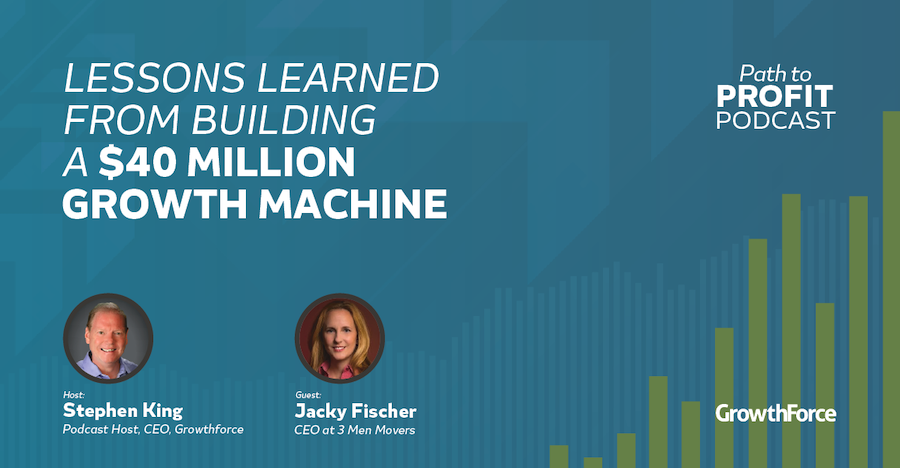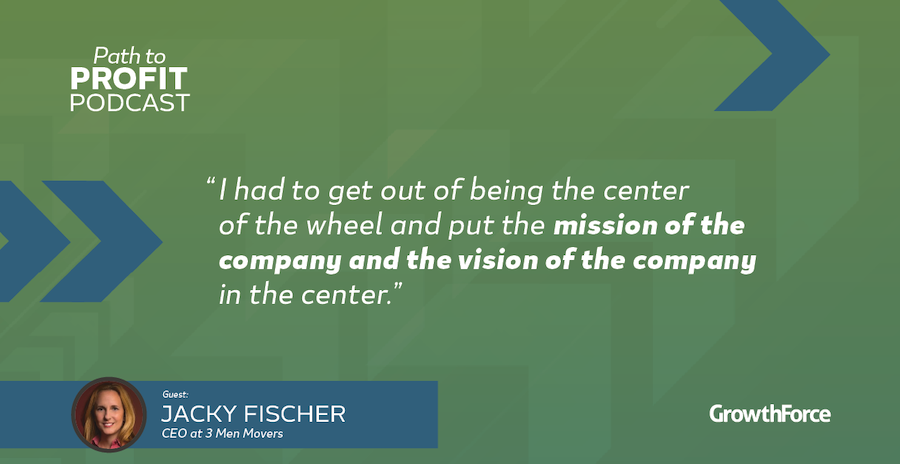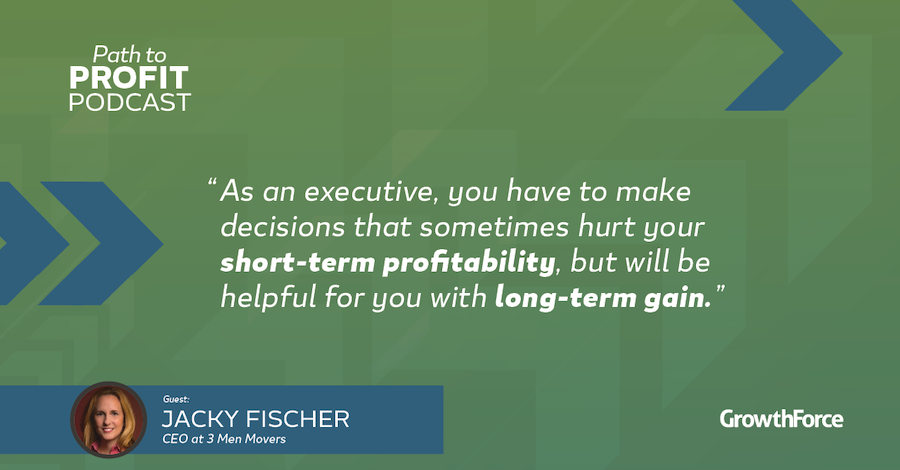7 min read

On the journey to growing a successful business, many entrepreneurs learn an essential lesson early on: growth can't happen unless you make the business more about the vision and less about the entrepreneur.
|
Key Takeaways
|
In a recent Path to Profit podcast episode, GrowthForce Founder and CEO, Stephen King sat down with Jacky Fischer, CEO of 3 Men Movers to discuss this essential business leadership lesson (and more).
By removing herself from the center and putting even more best practices into action, Fischer grew her family's moving company – a business that started when she was twelve years old in the back of her father's old furniture store delivery truck – into a $40 million business.
🎧 Don’t miss an episode! Subscribe & listen to more insightful conversations here!
If you’re looking to create a growth machine that generates impressive revenue and equally impressive profits- you’ve come to the right place. Take a page from Fischer’s handbook and apply her well-learned lessons to your own business…
7 Tips to Turn Your Business Into a Growth Machine
1. Put Your Mission and Vision at the Center
A corporate model that revolves solely around and is completely dependent upon the CEO or owner is not a successful model.
Business owners who have yet to learn this important lesson sit at the helm of businesses that cannot operate without their presence. As Fischer explained, if you're 15 minutes late to a meeting, then the meeting starts 15 minutes late. If you need to leave 10 minutes early, the meeting ends 10 minutes early. If you go on vacation, you can't actually take a break because your business still needs you in order to operate.
In other words, every time you are not available, your company is essentially put on pause, and no business can be successful when operating with a model that revolves around the business owner.
"I had to get out of being the center of the wheel and put the mission of the company and the vision of the company in the center," said Fischer.
This is the first lesson that every business owner needs to learn because all of the other lessons follow and serve this essential rule – that your business won't be successful if it revolves around you.
Removing yourself from the center of your business's operations requires you to change the way you operate. This shift of focus from "you" to mission & vision aligns everyone in your company around the same goals. It ensures they are equally capable of carrying out a meeting and making decisions if you're away.

2. Adopt an Operating System
The best way to put vision and mission at the center of your business model is with an operating system like the Entrepreneurial Operating System (EOS) created by Gino Wickman.[1] This system outlines a set of tools and processes that can be applied to any company's operations to help you proactively set goals and achieve them.
Read More: Why The Most Successful Businesses Run On Operating Frameworks
For example, using principles of the EOS, Fischer has implemented an entire system of meetings that are highly productive. The company has a daily morning huddle, weekly leadership meetings with her department heads that follow the EOS's Level 10 structure, weekly L10 departmental meetings, and weekly one-to-one meetings with each employee.
Yes, that sounds like a lot of meetings, but when you're following an EOS meeting structure, you're actually doing work in the meetings and all of this time represents time spent reviewing the company's metrics, checking in on ongoing projects, reporting issues, solving problems, setting goals, and assigning tasks.
"Once we had a set schedule and a set agenda, and it went on with or without me, I wasn't the most important thing in the room," said Fischer. "That's when we really started getting engagement and we really started growing because the team led the meeting."
3. Celebrate Failure, Adopt a Growth Mindset
So many business leaders fear failure, but failure is an opportunity to learn and it also represents the aftermath of a risk that was taken, and, sure, risks can result in failure, but they also sometimes result in success. Without risk, there's no success, and without failure, there's no learning, no opportunity to improve your business.
"Richard Branson just went up, and he's a risk-taker. We see him and Elon Musk as being very sexy because they take these big risks, and that's super cool and super sexy to be a risk-taker," Fischer said. "But then, when we think of the word failure, that's not so sexy. Nobody wants to be a failure, right? But you have to fail. If you're a risk-taker, you're going to have to tail because if you didn't fail, then it wouldn't be a risk. There [has to] be a potential for failure."
So, Fischer continued to explain that, when employees experience failure, those failures should be celebrated as learning opportunities – never reprimanded. When a failure in risk-taking is punished, employees stop making decisions and taking risks and they also stop sharing their failures, which means the business experiences failure without learning the bigger lessons from it.
Read More: Leveraging a Growth Mindset for Business Growth
When you can truly celebrate and learn from failure in your company and teach your employees to do the same, your business will adopt a growth mindset as part of its culture, and this mindset will help propel you to the next stages of your goals.
4. Don't Hold Your People Accountable (in the Traditional Sense)
If you have an employee underperforming, it can be incredibly frustrating. Fischer talked about how business owners might be laying in bed at night trying to figure out ways to hold employees accountable.
"You start thinking, 'Well, maybe I can pay him more money, or maybe I can write them up, or maybe I can threaten to fire them.' You have all these ideas of how you're going to force this person to do the job that they know how to do ... If you think about it, you're thinking about blackmailing, bribing, threatening ... to get somebody to do their job."
What Fischer has found is that most accountable people are accountable. If you're hiring the right people, then according to Fischer, "You don't have to do anything. You don't have to bribe them to do their job."
Fischer, instead, has taken the approach of focusing on company culture when she hires, ensuring someone is a good fit and shares the same values as the company. She then takes a more supportive role that supports her employees in their accountability. She ensures they have the tools, resources, training, and clearly communicated goals that they need to pursue the company's common vision.
"The more that I worked for [my employees]," said Fischer, "the more they were able to accomplish."

5. Align Metrics With Your Values
Every business owner knows how important it is to know their numbers. Not every business owner knows which numbers they should know, and keeping track of them all can often lead to a data overload where the numbers no longer tell a very meaningful story.
"Just because you can track everything doesn't mean you should," said Fischer.
She stressed the importance of identifying metrics that align with the company's core values and vision.
For example, one of her company's values is exceptional customer service and developing relationships with clients. To this point, the company tracks the number of moving appointments that each of her employees books and if they prefer to schedule appointments in person. However, they then realized the need for an online booking option for customers who don't want to talk to a person to schedule. So, they found a way to credit employees for promoting the online booking option, in addition to continuing to track the person-to-person scheduling metrics.
Additionally, if you're promoting teamwork, then you don't want to track metrics in a way that pits departments against each other in competition. Instead, track metrics that measure how well separate departments are supporting each other.
6. Always Put Company Culture First
In addition to tracking metrics that align with your culture, Fischer says that company culture and values must always be your number one priority – even if that means taking a loss in the short term.
Read More: How to Build a Successful Company Culture Committee
For example, if she has a salesperson leading in sales but who is a poor fit for the company culture, then she prioritizes the culture over the revenue.
One of her company's values is always doing what they say they are going to do. So, when a price gets quoted incorrectly in the customer's favor, they honor the quoted price even if they take a loss on the job. With 38,000 moving appointments booked per year, there are plenty of opportunities for mistakes to be made. So, prices get quoted wrong occasionally, but it's the company's policy to honor their word, and they always do.
7. Grow Your People
Fischer has a new book coming out titled The Growth Paradox: The Way to Run a Business Is Opposite of What You Think. As she put it, growing your business is not quite what you would expect. In that, as a business owner, you become less involved in the daily operations of the business and more involved in leadership, mentoring, coaching, and helping to grow your people.
It's necessary to look at the growth of your business and your goals for your business. If you're at $1 million now and want to get to $5 million in the next three years, you need to look at the actual number of sales that kind of growth requires, how many sales representatives are needed to generate that kind of revenue, and then you need to consider whether your current sales department head can handle managing 30 people instead of three.
This may mean moving on from employees who are not aligned with your business's goals. As Fischer's business grew, she had to let a lot of people go in order to replace them with more skilled, more capable employees.
However, Fischer has since learned that firing and replacing employees is not the best strategy for growing your people. The most efficient way to do it is to invest in the people you have. Not only is employee turnover one of the biggest hidden costs in business, but investing in employee training can generate a 10-times ROI.
Fischer's company has a growth plan for each employee that includes training them to expand with the business. As a result, she avoids the cost of turnover and her employees are happier and more engaged.
Read More: Lower Turnover & Boost Profits By Honoring Maslow's Hierarchy Of Needs
Build a Better Back Office to Support Your Growth
As your business grows, you not only need to help your people grow but also your back office. With an outsourced back office, your business can access a scalable solution to automated bookkeeping and accounting that grows right along with your company. So, you can continue to identify and track the metrics that align with your company's culture, core values, and human capital management strategy for long-term success and achievement.




